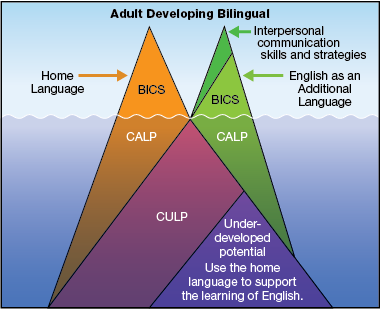Understanding the Acquisition of English as an Additional Language
|
← Back to Using Iceberg Models Scenario 4: High School and Adult English Language LearnersAndreas is a German-speaking international student enrolled in an Alberta high school. He is highly motivated to learn English and actively uses his extensive knowledge of German and a range of language-learning strategies to make connections between German and English that help him communicate in English and help accelerate his acquisition of English. He also appreciates the learning strategies that his teachers show him and encourage him to use. Andreas finds that even when his use of English is accurate, misunderstandings occur because of cultural differences between the way Canadians communicate in various contexts and how many German speakers communicate in those contexts. He really appreciates the explanations and advice he gets from friends that he made at school that help him understand, plan for, and navigate certain communication situations. As well, his teachers make a point of overtly explaining aspects of interpersonal communication in a Canadian context that he might not be aware of. Andreas’ German proficiency is nearly as fully developed as that of an adult native speaker of German, so English language development is not contributing substantially to German language development. Andreas’ profile is commonly referred to as adult developing bilingual because he is leveraging a fully developed first language to acquire another language.  While this model is labelled Adult Developing Bilingual, it also applies to English language learners in their late teens who are learning English in high school. This diagram illustrates how an adult uses his or her fully developed BICSBICS (basic interpersonal communicative skills): simple, functional language for communicating basic needs, ideas, and opinions and engaging in everyday conversations in informal social situations and CALPCALP (cognitive academic language proficiency): language required to understand and communicate about abstract concepts and accomplish a wide-range of cognitively demanding academic tasks, including reading textbooks, writing essays, and doing research in the first language to assist with acquiring English as an additional new language. CULP CULP (common underlying language proficiency) the language knowledge and skills that students develop as they learn one language that they can then use to help them learn other languages plays a significant role in language acquisition for adult developing bilingual learners. Adults often have an extensive vocabulary, as well as conceptual and abstract understanding in their home language, that can be transferred as they learn English as an additional language. Adults and high school-age students with fully developed academic language in their first language can often rapidly acquire an additional language, as they have many transferable skills, broad background knowledge, and prior experiences to draw upon to make meaning of a new language. However, adults often have highly accented speech with more first-language interference with English grammatical patterns. Implications for the Instruction of English Language Learners The adult developing bilingual profile is typical of English language learners who begin academic study in English at the high school level. Whether they have had some prior exposure to English or not, they generally have a significant linguistic and academic gap to close between the time they enter high school and when they hope to graduate. These students often do not have enough time to fully develop their academic language (CALP) while completing high school level courses and will continue to develop CALP later if they continue to be in an English immersive environment—especially if they continue academic studies in English. English language learners in high school benefit from strategies that help them make use of their home languagehome language: the dominant language that a student uses at home to communicate with family members to support their acquisition of English and their learning of academic concepts in English. They require assistance in building their academic vocabulary as rapidly as possible. Some students fitting this profile may also benefit from assistance in developing skills and strategies for effective interpersonal communications in English in a variety of contexts (e.g., small talk, turn-taking, interruptions during a conversation, personal space, body language, gestures, eye contact, and touch). |

